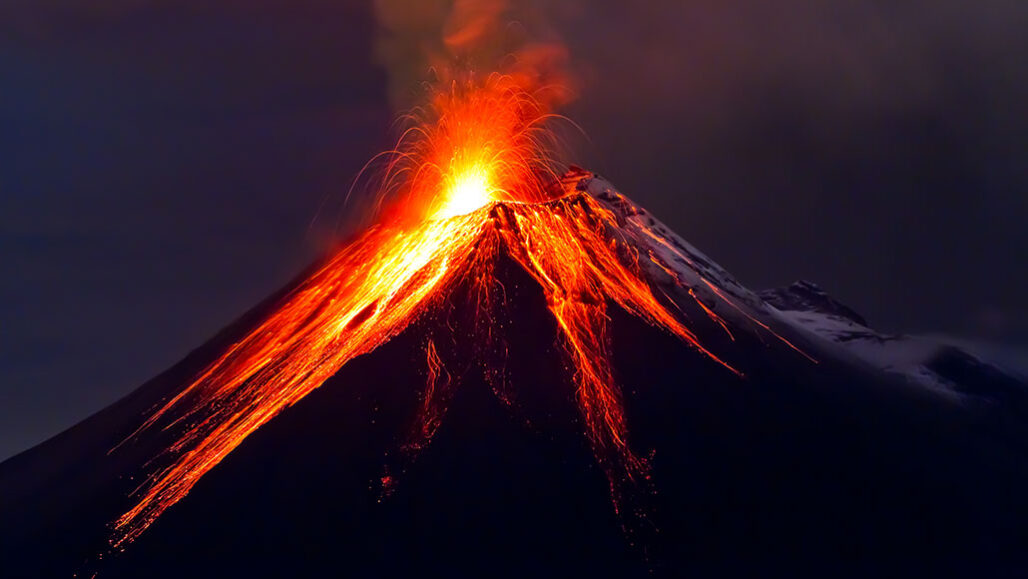ash: (in geology) Small, lightweight fragments of rock and glass spewed by volcanic eruptions. (in biology) A group of deciduous trees in the olive family that are popular in landscaping and for timber.
climate: The weather conditions that typically exist in one area, in general, or over a long period.
cloud: A plume of molecules or particles, such as water droplets, that move under the action of an outside force, such as wind, radiation or water currents. (in atmospheric science) A mass of airborne water droplets and ice crystals that travel as a plume, usually high in Earth’s atmosphere. Its movement is driven by winds. (in computing) A network of computers (hardware), known as servers, which are connected to the internet. They can be used to store data and computer programs (software) that can be accessed by one or many people at once, and from anywhere in the world.
crater: A large, bowl-shaped cavity in the ground or on the surface of a planet or the moon. They are typically caused by an explosion or the impact of a meteorite or other celestial body. Such an impact is sometimes referred to as a cratering event.
dinosaur: A term that means terrible lizard. These ancient reptiles lived from about 250 million years ago to roughly 65 million years ago. All descended from egg-laying reptiles known as archosaurs. Their descendants eventually split into two lines. For many decades, they have been distinguished by their hips. The lizard-hipped line are believed to have led to the saurichians, such as two-footed theropods like T. rex and the lumbering four-footed Apatosaurus (once known as brontosaurus). A second line of so-called bird-hipped, or ornithischian dinosaurs, appears to have led to a widely differing group of animals that included the stegosaurs and duckbilled dinosaurs. But a new 2017 analysis now calls into question that characterization of relatedness based on hip shap
earthquake: A sudden and sometimes violent shaking of the ground, sometimes causing great destruction, as a result of movements within Earth’s crust or of volcanic action.
extinction: The permanent loss of a species, family or larger group of organisms.
fire: The burning of some fuel, creating a flame that releases light and heat. (in neuroscience) The activation of a nerve or neural pathway.
ice sheet: A broad blanket of ice, often kilometers deep. Ice sheets currently cover most of Antarctica. An ice sheet also blankets most of Greenland. During the last glaciation, ice sheets also covered much of North America and Europe.
Pacific: The largest of the world’s five oceans. It separates Asia and Australia to the west from North and South America to the east.
planet: A celestial object that orbits a star, is big enough for gravity to have squashed it into a roundish ball and has cleared other objects out of the way in its orbital neighborhood. To accomplish the third feat, the object must be big enough to have pulled neighboring objects into the planet itself or to have slung them around the planet and off into outer space. Astronomers of the International Astronomical Union (IAU) created this three-part scientific definition of a planet in August 2006 to determine Pluto’s status. Based on that definition, IAU ruled that Pluto did not qualify. The solar system now includes eight planets: Mercury, Venus, Earth, Mars, Jupiter, Saturn, Uranus and Neptune.
Ring of Fire: An area around the Pacific Ocean’s edge where plate tectonics processes cause relatively frequent earthquakes and volcanic eruptions.
sea: An ocean (or region that is part of an ocean). Unlike lakes and streams, seawater — or ocean water — is salty.
tectonic: Surface activity on a large rocky body (such as a planet or moon) as liquid rock flows up to the surface where it solidifies, then slowly drifts atop molten rock, carrying surface features with it.
tectonic plates: The gigantic slabs — some spanning thousands of kilometers (or miles) across — that make up Earth’s outer layer.
toxic: Poisonous or able to harm or kill cells, tissues or whole organisms. The measure of risk posed by such a poison is its toxicity.
unique: Something that is unlike anything else; the only one of its kind.
Venus: The second planet out from the sun, it has a rocky core, just as Earth does. Venus lost most of its water long ago. The sun’s ultraviolet radiation broke apart those water molecules, allowing their hydrogen atoms to escape into space. Volcanoes on the planet’s surface spewed high levels of carbon dioxide, which built up in the planet’s atmosphere. Today the air pressure at the planet’s surface is 100 times greater than on Earth, and the atmosphere now keeps the surface of Venus a brutal 460° Celsius (860° Fahrenheit).
volcano: A place on Earth’s crust that opens, allowing magma and gases to spew out from underground reservoirs of molten material. The magma rises through a system of pipes or channels, sometimes spending time in chambers where it bubbles with gas and undergoes chemical transformations. This plumbing system can become more complex over time. This can result in a change, over time, to the chemical composition of the lava as well. The surface around a volcano’s opening can grow into a mound or cone shape as successive eruptions send more lava onto the surface, where it cools into hard rock.









